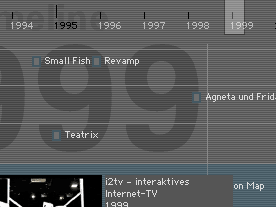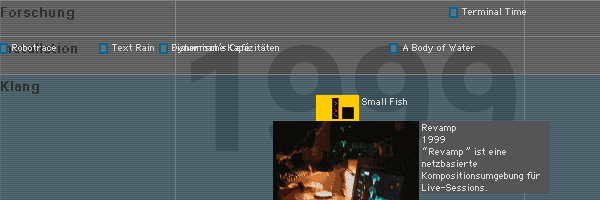|
|

|
||||||
|
|
|||||||
|
|
Art Context Internet The curators Christiane Paul, Steve Dietz and Jon Ippolito comment on online-exhibitions |
||||||
|
|
|||||||
|
|
|
|
|||||

|
|
||||||
|
|
|||||||
|
How does an online exhibition become an artistic event on the computer screen? In conjunction with continuing developments in the field of networking technology, artists and curators are trying out new presentation concepts that sound out the inherent properties of the network for virtual exhibition areas. The networked space defines a dynamic and collaborative context for presenting art. The roles of artists, curators and the public are redefined. The virtual exhibition is not conceived as a closed structure, but rather as a permanent process of art presentation, production and communication. In tandem with these strategies, the web interface largely defines how navigation through hypermedia structures becomes an experience of art. The navigational structure and the visual form are shaped by organization of information in alphabetical, semantic, spatial or time structures and by the links between them.
The Online-Exhibition
netzspannnug.org: Which content is suitable for the presentation in the virtual exhibition space and how do content and internet medium co-articulate? Christiane Paul: Presenting network art or »networked art« is not without its problems. Network art is created with the aim of being accessible to anyone, anywhere in the world and at any time. In this context, museums and galleries lose their legitimacy and some network artists are naturally keen to bypass the traditional art market, the existing system and the institutions.
Steve Dietz: Another way of thinking about this is what happens when medium and space are co-terminus--when the entire Internet is essentially the »space« of the virtual exhibition? With »
As to whether certain content is more suitable, I would simply say that different content presents different challenges. Work that relies on errors written to a server log file, for instance, will be literally inaccessible to a general public (such as: How are the concept of the content and design co-articulated? Which strategies from art, design, technology and architecture can be adapted usefully for exhibitions on the web. Jon Ippolito: Yet up to now most attempts to bridge this gap by presenting online art on a museum Web site have amounted to little more than the Internet equivalent of a brochure: the curator's bookmarks decorated by some explanatory text and thumbnail images. It's tempting to »leverage the traditional museum's resources and expertise« to create a virtual branch of your brick-and-mortar museum in cyberspace. But dressing up your Web site with Flash or Quicktime VR won't help if your fundamental paradigm is a brochure. Christiane Paul: I think it is difficult and problematic to take strategies from art, design, technology and architecture - which have been developed for the physical space - and apply them to the virtual space. Virtual spaces are n-dimensional rather than three-dimensional; they require a whole new approach and a completely different »language«. Obviously you can draw parallels - for example between the history of technology, conceptual art, performance and network art - but strategies nevertheless need to be completely redefined. What is the relevance of communication processes for the exhibition concept? Which forms of participation and representation should be offered to the users?
Steve Dietz: Communication processes are very relevant. Without wanting to prescribe hard and fast rules, I believe that an early exhibition like »PORT: How can the intersection of virtual and real place be made useful for the development of new online exhibition concepts?
Steve Dietz: Through ongoing and committed experimentation. I would say that in general many artist strategies become mainstream presentation strategies. In the most recent exhibition I curated, »Telematic Connections:
The online archive
The potential absence of limits on time or content creates the possibility for an exhibition context that is constantly reorganising itself. The openness of its structure demands strategies for integrating new projects into the collection, and strategies for inserting new contributions into an existing visual and conceptual context and for creating a context for the newly integrated work.
Networked archives
The timeline
To depict time-based developments, it makes sense to organise projects and discourses in chronological order - on a timeline. There are currently various timeline concepts on the Net. For example, in his exhibition »
The
The media art platform Rhizome also uses the concept of the timeline to contextualise the individual contributions. For each of the various forms of contribution such as interviews, comments, reviews, events and theory, a timebar is created based on the input order. All the timelines are organised alongside each other into a navigable netzspannung.org is working on the conception of a timeline that aims to make complex connections accessible in a structure that can be grasped intuitively. An extendable contextualisation system is to reveal how art, technology and theory are interlinked and under what circumstances the various concepts and technologies are used and further developed in the different types of media art production. An initial prototype, netzspannung.org/timeline, is based on using classic systematisation processes and assigning the projects particular characteristics such as creation time, categories, keywords and medium. This allows all the projects in one category to be put in order of the time they emerged. Through the parallel organisation of the timebars theory, research and technology, Net and stage, an interface emerges that is based on system-defined contextualisation and can give multi-disciplinary insights into development in media art, media technology and media theory.
Collaborative knowledge spaces
Fixed categories that demand clear allocations are being replaced by clusters of related content. A neural network organises the content on the basis of semantic text analyses. This system-generated contextualisation forms the basis for an open cartography of media culture production that can, among other possibilities be visualised in a timeline. The experiment consists of investigating the extent to which it is possible to combine semantic text analysis and human expertise and to use them in the structuring and visualisation of a constantly expanding online archive. Open and flexible structures also make it easier to connect up different archives - or distributed knowledge - to specific joint presentation contexts. In a development that goes beyond systematisation in rigid structures or in dynamic »semantic maps«, the user or his or her behaviour can be included in the process of contextualising projects within an online archive. Because the evaluation of the user's navigation routes is assigned to the received documents as metadata, this information can flow into the visualisation as an additional structure. The connection of the online archive with a community platform also allows the presentation modules to be connected with a personal online workspace. The collection thereby becomes a location where the user's activity and personal reflections are also manifested. In the personal workspace the »timeline« becomes a tool for bringing to life a user's own view of the connection between different projects.
For this year's |
|||||||









 Intro
Intro